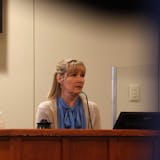State utility regulators got an earful Friday morning in an unusual public meeting over Enbridge's proposed oil pipeline across northern Minnesota.
More than 100 people filled a Minnesota Senate Office Building hearing room Friday, with more watching a video feed in an adjacent room.
Supporters told the Minnesota Public Utilities Commission (PUC) to finish the job it started and again approve a much-studied $2.6 billion pipeline — a replacement for the company's aging Line 3 — that they say would improve oil transport safety and create thousands of construction jobs.
"We just can't flip the switch and stop providing fossil fuels," said Phillip Wallace, a union representative for pipeline construction welders in Minnesota and North Dakota. "Transporting oil through a new state-of-the-art pipeline is the right thing to do."
Opponents told the four PUC commissioners this was their last chance to stop an environmental fiasco that would worsen climate change and threaten a new region of Minnesota lakes and rivers with a crude-oil spill.
"We are in an unfolding climate catastrophe and climate chaos is one of the biggest risks to water," said Christy Dolph, a university water resource researcher from Minneapolis. "We need to move away from fossil fuels now."
The opinions are just as divergent as the first time the PUC took up the pipeline request. The project is back before the panel because the Minnesota Court of Appeals found the project's environmental impact statement (EIS) to be flawed. After the Minnesota Department of Commerce addressed the concern, the PUC on Friday kicked off hearings on the controversial pipeline that would ferry Canadian oil to Enbridge's terminal in Superior, Wis.
Ruling expected next week



